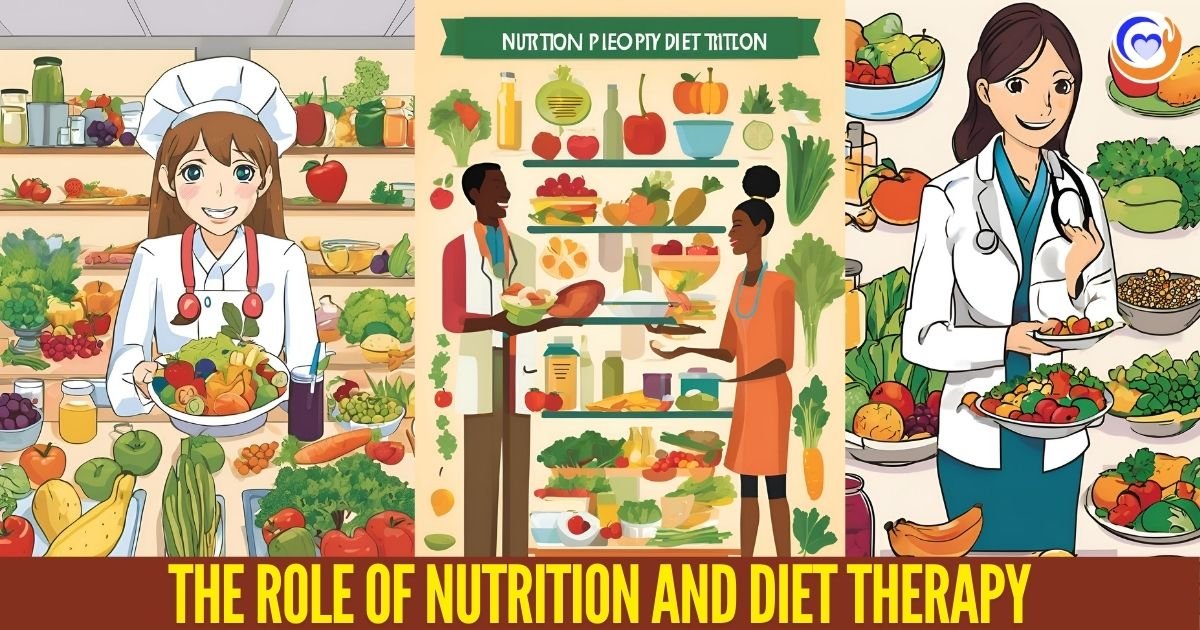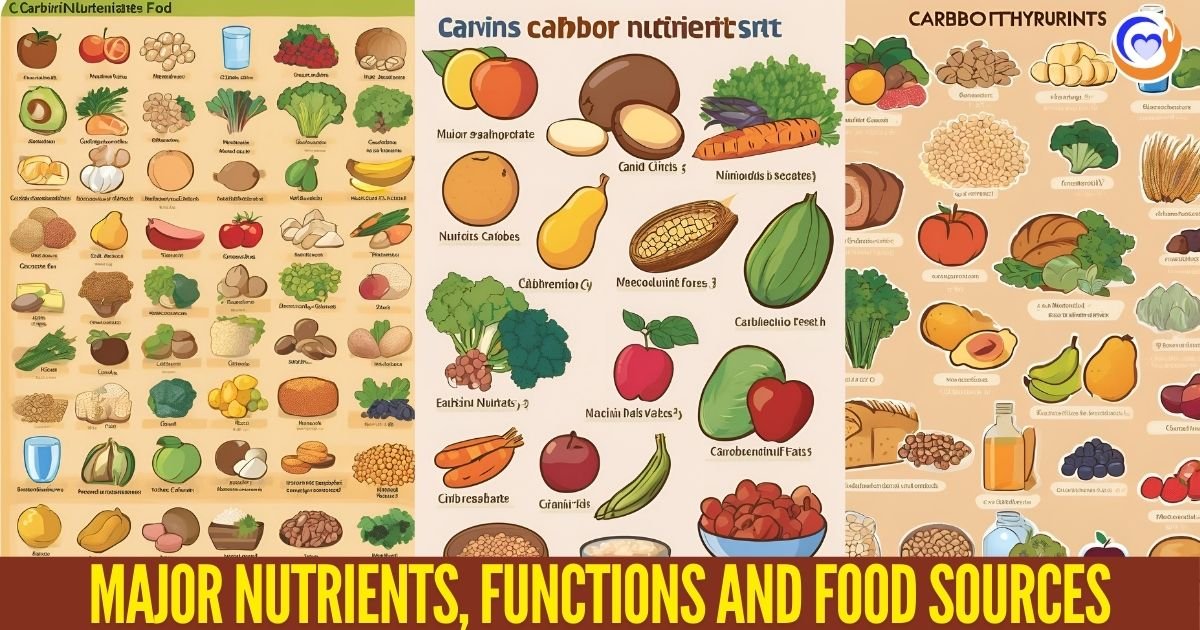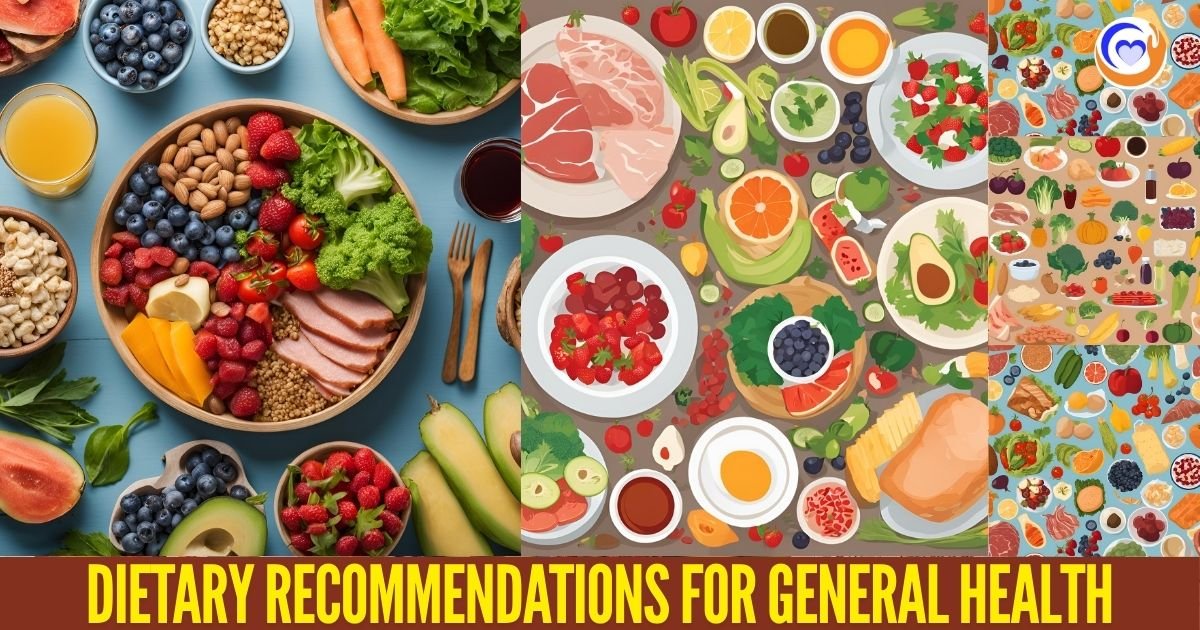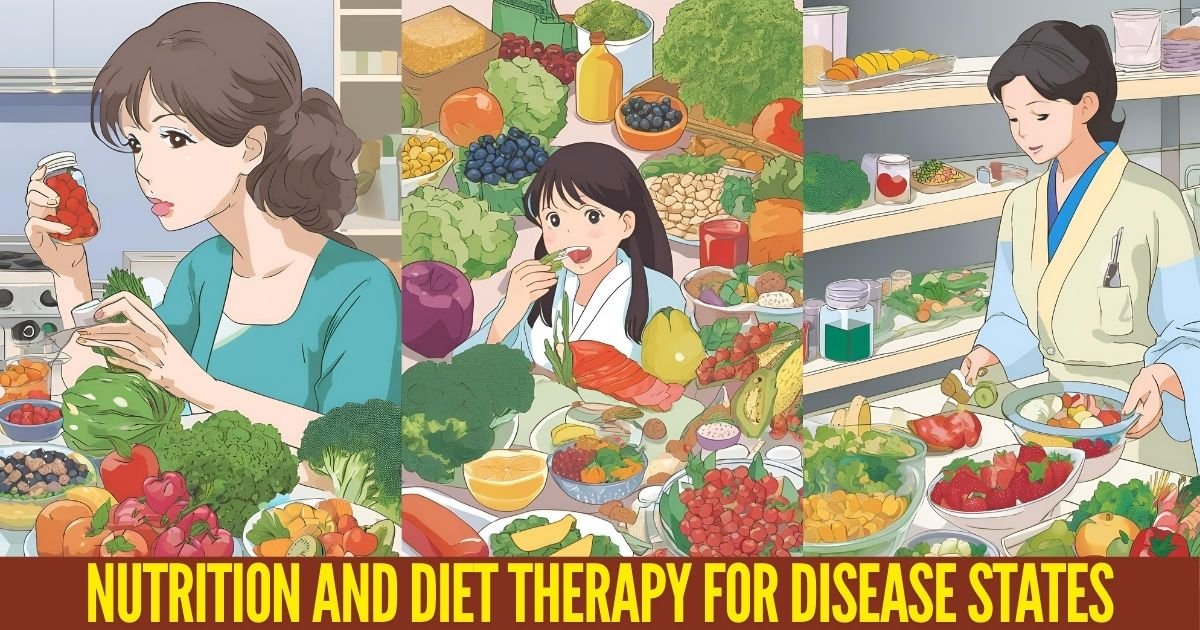Introduction
Nutrition and diet therapy plays a crucial role in health promotion and disease prevention and treatment. Nutrition and diet therapy plays a crucial role in health promotion and disease prevention and treatment. What we eat affects our risk of developing various acute and chronic diseases and conditions. Dietitians and nutritionists have an important role in educating patients and clients about healthy eating patterns and recommending diets to treat specific diseases and conditions.
This essay will provide an overview of nutrition and diet therapy, discuss the role of dietitians and nutritionists, explain major nutrient requirements and dietary guidelines, and examine the use of nutrition and diet therapy for several disease states.
Read More: Diet Coke Nutritional Fact and effect at Human Health
The Role of Nutrition and Diet Therapy

Dietitians and nutritionists are experts in food, nutrition, and dietetics. They advise people on what to eat to lead a healthy lifestyle or achieve a specific health goal. Dietitians usually have a degree in dietetics, nutrition, or a related field.
They also complete supervised practice programs and pass a national exam to become licensed or registered dietitians (RDDs or RDNs). RDs work in various settings including hospitals, long-term care facilities, outpatient clinics, food service operations, corporations, schools, and private practice. Some of the key responsibilities of dietitians include:
– Assessing the nutritional needs of clients based on medical history, lifestyle, medication use, physical examination, and lab data
– Developing customized nutrition care plans and recommending dietary changes to manage health conditions and meet nutritional goals
– Counseling clients on food choices, meal planning, grocery shopping, and preparation techniques
– Designing menus and overseeing food service operations for healthcare facilities or corporate dining services
– Providing nutrition education through teaching classes and writing articles and brochures
– Maintaining patient privacy and confidentiality while communicating with other healthcare team members
– Monitoring clients’ progress and modifying nutrition interventions as needed
Nutritionists have similar roles but credentials and qualifications vary. Some have graduate degrees in nutrition or related sciences. Others may have certificates in nutrition, but not licensed dietitian status. Nutritionists counsel clients on food choices and dietary patterns but do not provide medical nutrition therapy for specific diseases.
Major Nutrients, Functions and Food Sources

Carbohydrates, protein, and fats are the major macronutrients required for health. Vitamins, minerals, and water are also essential micronutrients. Here is an overview of the main nutrients:
Carbohydrates: Found in grains, fruits, vegetables, beans, and dairy foods. Carbs provide energy, fiber, vitamins, and minerals. Complex carbs including whole grains are healthier choices than refined/processed carbs.
Protein: Found in meat, poultry, seafood, eggs, dairy foods, nuts, seeds, and beans. Protein is needed to build and repair tissues and make enzymes and hormones. Animal and plant proteins are complete proteins with all essential amino acids.
Fats: Found in oils, butter, nuts, seeds, meats, poultry skin, and high-fat dairy foods. Fats provide energy, help absorb fat-soluble vitamins, and make hormones and cell membranes. Limit saturated and trans fats. Choose healthier unsaturated fats.
Vitamins/Minerals: Found in fruits, vegetables, whole grains, dairy, and protein foods. They have various functions including bone health, cell function, energy metabolism, immune function, and antioxidant activity.
Water: Found in beverages and foods with high water content like fruits, vegetables, and soups. Critical for digestion, nutrient absorption, circulation, and elimination of waste.
Dietary Recommendations for General Health

Federal agencies including the U.S. Department of Agriculture (USDA) and Department of Health and Human Services (HHS) publish dietary guidelines for Americans every 5 years based on current nutrition science. The latest edition is the 2020-2025 Dietary Guidelines which provides recommendations on overall healthy eating patterns:
– Focus on variety, nutrient density, and amount. Choose a variety of nutrient-dense foods across and within all food groups in recommended amounts. Limit calories from added sugars and saturated fat and reduce sodium intake.
– Make half your plate fruits and vegetables. Eat a variety of vegetables from all subgroups—dark green, red and orange, legumes, starchy. Eat whole fruits.
– Half the grains should be whole grains. Choose 100% whole-grain bread, cereals, crackers, pasta, and brown rice.
– Vary protein routine. Eat seafood, lean meats and poultry, eggs, legumes (beans and peas), nuts, seeds and soy products.
– Switch to low-fat or fat-free milk, yogurt, and cheese. Drink fortified soy beverages if desired. Limit regular cheese and ice cream.
– Limit sodium, saturated fat, added sugars, and refined grains like white bread.
– Stay hydrated. Choose water, unsweetened tea, and coffee. Limit sugary drinks.
– Support healthy eating patterns for all. Tailor recommendations for children, older adults, vegetarians, religious groups, and ethnic cuisines.
These guidelines form the basis for planning a healthy, balanced diet that provides all the nutrients needed for good health while reducing chronic disease risks.
Nutrition and Diet Therapy for Disease States

Medical nutrition therapy is the use of specific nutrition interventions to treat an illness, injury, or condition. Individualized diet plans are designed to address nutritional deficiencies, promote healing, minimize symptoms, and improve overall health. Here is an overview of nutrition goals and dietary strategies for several common conditions:
Diabetes Mellitus: Goals are blood glucose control, lipid management, blood pressure control, and weight management. Diet strategies include carbohydrate counting, small frequent meals, limiting concentrated sweets and high-glycemic foods, and emphasizing high-fiber foods, lean proteins, and healthy fats.
Hypertension: The goal is to lower and control blood pressure. Diet strategies include the DASH diet emphasizing fruits, vegetables, low-fat dairy, whole grains, lean proteins, nuts, and seeds. Limit sodium, sweets, sugar-sweetened beverages, and alcohol.
Celiac Disease: The goal is to avoid gluten to manage symptoms and prevent complications. Strictly avoid foods containing wheat, barley, and rye by choosing certified gluten-free foods labeled with the GF logo. Read labels diligently.
Chronic Kidney Disease: The goals are limiting buildup of waste products and managing fluid and electrolytes. Diet strategies include limiting sodium, potassium, phosphorus, and protein based on lab values. Fluid restrictions may be needed.
Cancer: Goals are providing adequate calories and protein to prevent malnutrition during treatment. Small frequent meals, nutritious snacks, and supplements are often needed. Low-bacteria diet is recommended during periods of low immunity.
Gastrointestinal Disorders: Modifications depend on specific conditions like ulcers, IBS, and IBD. Goals involve preventing flare-ups of symptoms like gas, cramping, diarrhea, or constipation through dietary changes. Fiber, lactose, and fat modifications may be required.
Weight Management: The goal is weight loss of 1-2 lbs per week through calorie reduction of 500-1000 calories per day from diet and exercise. Diets lower in fat, and high in protein and fiber provide satiety. Portion control and food tracking are key strategies. Very low-calorie diets and commercial diets require medical supervision.
Eating disorders: Anorexia and bulimia treatment requires a multidisciplinary medical and mental health team. Goals involve gradually increasing calories and restoring health while treating underlying psychological issues. Re-feeding syndrome is a risk.
As shown in these examples, nutrition and diet therapy play an integral role in disease management to improve clinical outcomes. Nutrition interventions require in-depth nutrition knowledge, expertise in medical nutrition therapy protocols, and coordination with the healthcare team.
Read more :
Conclusion
Proper nutrition is essential for good health, disease prevention, and treatment. Dietitians and nutritionists have extensive training in diet planning, nutrition assessment, and medical nutrition therapy. They counsel clients based on their health history and nutritional requirements to meet guidelines and individualize care.
Nutrition and diet therapy improve disease management and quality of life across diverse conditions like diabetes, kidney disease, hypertension, cancer, and gastrointestinal disorders. Following evidence-based nutrition recommendations and guidance from credentialed dietitians helps optimize health outcomes.
This essay provides a broad overview of the important role nutrition and diet therapy plays in health promotion and chronic disease management. Many additional topics could be explored such as community nutrition programs, public health campaigns, alternative nutrition therapies, and nutrition support for critically ill patients, legislative policies related to nutrition, and more.
However, this essay highlights some of the major elements of nutrition and diet therapy in 4000 words. Further exploration of this multifaceted, complex, and evolving field would require more in-depth analysis and discussion.
FAQ
Q: What is the role of nutrition and diet therapy in health?
A: Nutrition and diet therapy promote health, prevent diseases, and support recovery by optimizing nutrient intake and managing dietary habits.
Q: How do dietitians and nutritionists differ in their roles?
A: Dietitians are licensed experts who can provide medical nutrition therapy, while nutritionists often focus on general food and health advice but may lack licensing.
Q: What are the main nutrient categories required for a balanced diet?
A: The essential nutrient categories are carbohydrates, proteins, fats, vitamins, minerals, and water, each playing a critical role in body function.
Q: How do carbohydrates contribute to a healthy diet?
A: Carbohydrates provide energy and fiber and are found in grains, fruits, and vegetables. Choosing whole grains over refined carbs is generally recommended.
Q: Why is protein intake important, and what are good protein sources?
A: Protein is essential for tissue repair and hormone production. Good sources include lean meats, dairy, eggs, beans, nuts, and seeds.
Q: What are some effective dietary guidelines for general health?
A: Guidelines include focusing on variety, eating more fruits and vegetables, choosing whole grains, and limiting added sugars, sodium, and saturated fats.
Q: How does nutrition therapy support diabetes management?
A: Nutrition therapy for diabetes involves carbohydrate management, fiber intake, and healthy fats to maintain stable blood sugar levels and reduce risks.
Q: What dietary modifications are necessary for hypertension?
A: The DASH diet is often recommended, emphasizing fruits, vegetables, whole grains, lean proteins, and low sodium to support blood pressure control.
Q: What is the role of diet in chronic kidney disease?
A: In kidney disease, nutrition therapy limits protein, sodium, potassium, and phosphorus to reduce waste buildup and maintain fluid and electrolyte balance.
Q: Can nutrition therapy help in cancer treatment?
A: Yes, adequate calories and protein are crucial to prevent malnutrition in cancer patients. Small, frequent meals and nutrient-dense snacks can support recovery.


